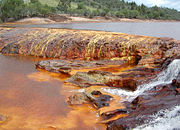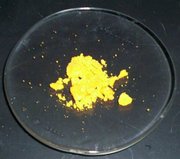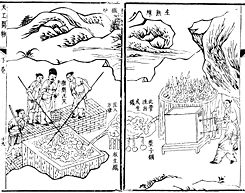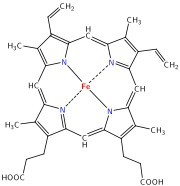Iron
2008/9 Schools Wikipedia Selection. Related subjects: Chemical elements; Geology and geophysics
|
|||||||||||||||||||||||||||||||||||||||||||||||||
| General | |||||||||||||||||||||||||||||||||||||||||||||||||
|---|---|---|---|---|---|---|---|---|---|---|---|---|---|---|---|---|---|---|---|---|---|---|---|---|---|---|---|---|---|---|---|---|---|---|---|---|---|---|---|---|---|---|---|---|---|---|---|---|---|
| Name, symbol, number | iron, Fe, 26 | ||||||||||||||||||||||||||||||||||||||||||||||||
| Chemical series | transition metals | ||||||||||||||||||||||||||||||||||||||||||||||||
| Group, period, block | 8, 4, d | ||||||||||||||||||||||||||||||||||||||||||||||||
| Appearance | lustrous metallic with a grayish tinge  |
||||||||||||||||||||||||||||||||||||||||||||||||
| Standard atomic weight | 55.845 (2) g·mol−1 | ||||||||||||||||||||||||||||||||||||||||||||||||
| Electron configuration | [Ar] 3d6 4s2 | ||||||||||||||||||||||||||||||||||||||||||||||||
| Electrons per shell | 2, 8, 14, 2 | ||||||||||||||||||||||||||||||||||||||||||||||||
| Physical properties | |||||||||||||||||||||||||||||||||||||||||||||||||
| Phase | solid | ||||||||||||||||||||||||||||||||||||||||||||||||
| Density (near r.t.) | 7.874 g·cm−3 | ||||||||||||||||||||||||||||||||||||||||||||||||
| Liquid density at m.p. | 6.98 g·cm−3 | ||||||||||||||||||||||||||||||||||||||||||||||||
| Melting point | 1811 K (1538 ° C, 2800 ° F) |
||||||||||||||||||||||||||||||||||||||||||||||||
| Boiling point | 3134 K (2862 ° C, 5182 ° F) |
||||||||||||||||||||||||||||||||||||||||||||||||
| Heat of fusion | 13.81 kJ·mol−1 | ||||||||||||||||||||||||||||||||||||||||||||||||
| Heat of vaporization | 340 kJ·mol−1 | ||||||||||||||||||||||||||||||||||||||||||||||||
| Specific heat capacity | (25 °C) 25.10 J·mol−1·K−1 | ||||||||||||||||||||||||||||||||||||||||||||||||
|
|||||||||||||||||||||||||||||||||||||||||||||||||
| Atomic properties | |||||||||||||||||||||||||||||||||||||||||||||||||
| Crystal structure | body-centered cubic a=286.65 pm; face-centered cubic between 1185–1667 K |
||||||||||||||||||||||||||||||||||||||||||||||||
| Oxidation states | 6, 5 , 4, 3, 2, 1 ( amphoteric oxide) |
||||||||||||||||||||||||||||||||||||||||||||||||
| Electronegativity | 1.83 (Pauling scale) | ||||||||||||||||||||||||||||||||||||||||||||||||
| Ionization energies ( more) |
1st: 762.5 kJ·mol−1 | ||||||||||||||||||||||||||||||||||||||||||||||||
| 2nd: 1561.9 kJ·mol−1 | |||||||||||||||||||||||||||||||||||||||||||||||||
| 3rd: 2957 kJ·mol−1 | |||||||||||||||||||||||||||||||||||||||||||||||||
| Atomic radius | 140 pm | ||||||||||||||||||||||||||||||||||||||||||||||||
| Atomic radius (calc.) | 156 pm | ||||||||||||||||||||||||||||||||||||||||||||||||
| Covalent radius | 125 pm | ||||||||||||||||||||||||||||||||||||||||||||||||
| Miscellaneous | |||||||||||||||||||||||||||||||||||||||||||||||||
| Magnetic ordering | ferromagnetic | ||||||||||||||||||||||||||||||||||||||||||||||||
| 1043 K | |||||||||||||||||||||||||||||||||||||||||||||||||
| Electrical resistivity | (20 °C) 96.1 nΩ·m | ||||||||||||||||||||||||||||||||||||||||||||||||
| Thermal conductivity | (300 K) 80.4 W·m−1·K−1 | ||||||||||||||||||||||||||||||||||||||||||||||||
| Thermal expansion | (25 °C) 11.8 µm·m−1·K−1 | ||||||||||||||||||||||||||||||||||||||||||||||||
| Speed of sound (thin rod) | ( r.t.) (electrolytic) 5120 m·s−1 |
||||||||||||||||||||||||||||||||||||||||||||||||
| Young's modulus | 211 GPa | ||||||||||||||||||||||||||||||||||||||||||||||||
| Shear modulus | 82 GPa | ||||||||||||||||||||||||||||||||||||||||||||||||
| Bulk modulus | 170 GPa | ||||||||||||||||||||||||||||||||||||||||||||||||
| Poisson ratio | 0.29 | ||||||||||||||||||||||||||||||||||||||||||||||||
| Mohs hardness | 4.0 | ||||||||||||||||||||||||||||||||||||||||||||||||
| Vickers hardness | 608 MPa | ||||||||||||||||||||||||||||||||||||||||||||||||
| Brinell hardness | 490 MPa | ||||||||||||||||||||||||||||||||||||||||||||||||
| CAS registry number | 7439-89-6 | ||||||||||||||||||||||||||||||||||||||||||||||||
| Selected isotopes | |||||||||||||||||||||||||||||||||||||||||||||||||
|
|||||||||||||||||||||||||||||||||||||||||||||||||
| References | |||||||||||||||||||||||||||||||||||||||||||||||||
Iron (pronounced /ˈˈī(-ə)rn/) is a chemical element with the symbol Fe (Latin: ferrum) and atomic number 26. Iron is a group 8 and period 4 element. Iron is a lustrous, silvery soft metal. It is one of the few ferromagnetic elements.
Iron and nickel are notable for being the final elements produced by stellar nucleosynthesis, and are therefore the heaviest elements which do not require a red giant or supernova for formation. Iron and nickel are therefore the most abundant metals in metallic meteorites and in the dense-metal cores of planets such as Earth. Iron and iron alloys are also the most common source of ferromagnetic materials in everyday use.
Occurrence
Iron is believed to be the sixth most abundant element in the universe, formed as the final act of nucleosynthesis by carbon burning in massive stars. While it makes up only about 5% of the Earth's crust, the earth's core is believed to consist largely of an iron-nickel alloy comprising 35% of the mass of the Earth as a whole. Iron is consequently the most abundant element on Earth, but only the fourth most abundant element in the Earth's crust where it is the second most abundant metal after aluminium. Most of the iron in the crust is found combined with oxygen as iron oxide minerals such as hematite and magnetite.. About 1 in 20 meteorites consist of the unique iron-nickel minerals taenite (35-80% iron) and kamacite (90-95% iron). Although rare, meteorites are the major form of natural metallic iron on the earth's surface.
The reason for Mars' red colour is thought to be an iron-oxide-rich soil.
Characteristics
Iron is a metal extracted mainly from the iron ore hematite. It oxidises readily in air and water to form Fe2O3 and is rarely found as a free element. In order to obtain elemental iron, oxygen and other impurities must be removed by chemical reduction. The properties of iron can be modified by alloying it with various other metals and some non-metals, notably carbon and silicon to form steels.
Nuclei of iron have some of the highest binding energies per nucleon, surpassed only by the nickel isotope 62Ni. The universally most abundant of the highly stable nuclides is, however, 56Fe. This is formed by nuclear fusion in stars. Although a further tiny energy gain could be extracted by synthesizing 62Ni, conditions in stars are unsuitable for this process to be favoured, and iron abundance on Earth greatly favors iron over nickel, and also presumably in supernova element production.
Iron (as Fe2+, ferrous ion) is a necessary trace element used by almost all living organisms. The only exceptions are several organisms that live in iron-poor environments and have evolved to use different elements in their metabolic processes, such as manganese instead of iron for catalysis, or hemocyanin instead of hemoglobin. Iron-containing enzymes, usually containing heme prosthetic groups, participate in catalysis of oxidation reactions in biology, and in transport of a number of soluble gases. See hemoglobin, cytochrome, and catalase.
Allotropes
Iron represents perhaps the best-known example for allotropy in a metal. There are four allotropic forms of iron, known as alpha, beta, gamma, and delta.
As molten iron cools down it crystallises at 1535°C into its delta allotrope, which has a body-centred cubic (BCC) crystal structure. As it cools further its crystal structure changes to face-centred cubic (FCC) at 1401°C, when it is known as gamma-iron, or austenite. At 912°C the crystal structure again becomes BCC as beta-iron4 is formed, and at 770°C (the Curie point, Tc ) the iron becomes magnetic as alpha-iron, also known as ferrite, which is also BCC, is formed. Thus there is no change in crystalline structure, but there is a change in 'domain structure', where each domain contains iron atoms with a particular electronic spin. In unmagnetised iron, all the electronic spins of the atoms within one domain are in the same direction. However, in neighbouring domains they point in various directions and thus cancel out. In magnetised iron, the electronic spins of all the domains are all aligned, so that the magnetic effects of neighbouring domains reinforce each other. Although each domain contains billions of atoms, they are very small, about one thousandth of a centimetre across.
Iron, of course, is of most importance when mixed with certain other metals and with carbon to form steels. There are many types of steels, all with different properties; and an understanding of the properties of the allotropes of iron is key to the manufacture of good quality steels.
Alpha iron, also known as ferrite, is the most stable form of iron at normal temperatures. It is a fairly soft metal that can dissolve only a small concentration of carbon (no more than 0.021% by mass at 910 °C).
Above 912°C and up to 1401°C alpha iron undergoes a phase transition from body-centred cubic to the face-centred cubic configuration of gamma iron, also called austenite. This is similarly soft and metallic but can dissolve considerably more carbon (as much as 2.04% by mass at 1146°C). This form of iron is used in the type of stainless steel used for making cutlery, and hospital and food-service equipment.
Applications
Iron is the most widely used of all the metals, accounting for 95% of worldwide metal production. Its low cost and high strength make it indispensable in engineering applications such as the construction of machinery and machine tools, automobiles, the hulls of large ships, and structural components for buildings. Since pure iron is quite soft, it is most commonly used in the form of steel. Some of the forms in which iron is produced commercially include:
- Pig iron has 3.5—4.5% carbon and contains varying amounts of contaminants such as sulfur, silicon and phosphorus. Its only significance is that of an intermediate step on the way from iron ore to cast iron and steel.
- Cast iron contains 2—4% carbon, 1—6% silicon, and small amounts of manganese. Contaminants present in pig iron that negatively affect material properties, such as sulfur and phosphorus, have been reduced to an acceptable level. It has a melting point in the range of 1420—1470 K, which is lower than either of its two main components, and makes it the first product to be melted when carbon and iron are heated together. Its mechanical properties vary greatly, dependent upon the form carbon takes in the alloy. 'White' cast irons contain their carbon in the form of cementite, or iron carbide. This hard, brittle compound dominates the mechanical properties of white cast irons, rendering them hard, but unresistant to shock. The broken surface of a white cast iron is full of fine facets of the broken carbide, a very pale, silvery, shiny material, hence the appellation. In grey iron the carbon exists free as fine flakes of graphite, and also renders the material brittle due to the stress-raising nature of the sharp edged flakes of graphite. A newer variant of grey iron, referred to as ductile iron is specially treated with trace amounts of magnesium to alter the shape of graphite to spheroids, or nodules, vastly increasing the toughness and strength of the material.
- Wrought iron contains less than 0.25% carbon. It is a tough, malleable product, but not as fusible as pig iron. If honed to an edge, it loses it quickly. Wrought iron is characterised by the presence of fine fibers of slag entrapped in the metal. Wrought iron is more corrosion resistant than steel. It has been almost completely replaced by mild steel for traditional "wrought iron" products and blacksmithing. Mild steel does not have the same corrosion resistance but is cheaper and more widely available.
- Carbon steel contains 2.0% carbon or less, with small amounts of manganese, sulfur, phosphorus, and silicon.
- Alloy steels contain varying amounts of carbon as well as other metals, such as chromium, vanadium, molybdenum, nickel, tungsten, etc. They are used for structural purposes, as their alloy content raises their cost and necessitates justification of their use. Recent developments in ferrous metallurgy have produced a growing range of microalloyed steels, also termed 'HSLA' or high-strength, low alloy steels, containing tiny additions to produce high strengths and often spectacular toughness at minimal cost.
- Iron(III) oxides are used in the production of magnetic storage media in computers. They are often mixed with other compounds, and retain their magnetic properties in solution.
The main disadvantage of iron and steel is that pure iron, and most of its alloys, suffer badly from rust if not protected in some way. Painting, galvanization, passivation, plastic coating and bluing are some techniques used to protect iron from rust by excluding water and oxygen or by sacrificial protection.
Iron is believed to be the critical missing nutrient in the ocean that limits the growth of plankton. Experimental iron fertilization of areas of the ocean using iron(II) sulfate has proven successful in increasing plankton growth. Larger scaled efforts are being attempted with the hope that iron seeding and ocean plankton growth can remove carbon dioxide from the atmosphere, thereby counteracting the greenhouse effect that is generally agreed by climatologists to cause global warming.
Iron compounds
- Iron(III) acetate (Fe(C2H3O2)3 is used in the dyeing of cloth.
- Iron(III) ammonium oxalate (Fe(NH4)3(C2O4)4) is used in blueprints.
- Iron(III) arsenate (FeAsO4) is used in insecticide.
- Iron(III) chloride (FeCl3) is used: in water purification and sewage treatment, in the dyeing of cloth, as a coloring agent in paints, as an additive in animal feed, and as an etching material for engravement, photography and printed circuits.
- Iron(III) chromate (Fe2(CrO4)3) is used as a yellow pigment for paints and ceramic.
- Iron(III) hydroxide (Fe(OH)3) is used as a brown pigment for rubber and in water purification systems.
- Iron(III) phosphate (FePO4) is used in fertilizer and as an additive in human and animal food.
- Iron(II) acetate (Fe(C2H3O2)2 is used in the dyeing of fabrics and leather, and as a wood preservative.
- Iron(II) gluconate (Fe(C6H11O7)2) is used as a dietary supplement in iron pills.
- Iron(II) oxalate (FeC2O4) is used as yellow pigment for paints, plastics, glass and ceramic, and in photography.
- Iron(II) sulfate (FeSO4) is used in water purification and sewage treatment systems, as a catalyst in the production of ammonia, as an ingredient in fertilizer and herbicide, as an additive in animal feed, in wood preservative and as an additive to flour to increase iron levels.
- Iron-Fluorine complex (FeF6)3- is found in solutions containing both Fe(III) ions and fluoride ions.
Historical aspects
The first iron used by mankind during prehistory came from meteors. The smelting of iron in bloomeries probably began in Anatolia or the Caucasus in the second millennium BC or the latter part of the preceding one. Cast iron was first produced in China about 550 BC, but not in Europe until the medieval period. During the medieval period, means were found in Europe of producing wrought iron from cast iron (in this context known as pig iron) using finery forges. For all these processes, charcoal was required as fuel.
Steel (with a smaller carbon content than pig iron but more than wrought iron) was first produced in antiquity. New methods of producing it by carburizing bars of iron in the cementation process were devised in the 17th century AD. In the Industrial Revolution, new methods of producing bar iron without charcoal were devised and these were later applied to produce steel. In the late 1850s, Henry Bessemer invented a new steelmaking process, involving blowing air through molten pig iron, to produce mild steel. This and other 19th century and later processes have led to wrought iron no longer being produced.
Production of iron from iron ore
The production of iron or steel is a process unless the desired final product is cast iron. The first stage is to produce pig iron in a blast furnace. The second is to make wrought iron or steel from pig iron by a further process.
Blast furnace
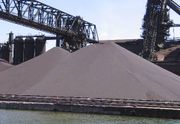
Ninety percent of all mining of metallic ores is for the extraction of iron. Industrially, iron is produced starting from iron ores, principally haematite (nominally Fe2O3) and magnetite (Fe3O4) by a carbothermic reaction (reduction with carbon) in a blast furnace at temperatures of about 2000 °C. In a blast furnace, iron ore, carbon in the form of coke, and a flux such as limestone (which is used to remove impurities in the ore which would otherwise clog the furnace with solid material) are fed into the top of the furnace, while a blast of heated air is forced into the furnace at the bottom.
In the furnace, the coke reacts with oxygen in the air blast to produce carbon monoxide:
The carbon monoxide reduces the iron ore (in the chemical equation below, hematite) to molten iron, becoming carbon dioxide in the process:
The flux is present to melt impurities in the ore, principally silicon dioxide sand and other silicates. Common fluxes include limestone (principally calcium carbonate) and dolomite (calcium-magnesium carbonate). Other fluxes may be used depending on the impurities that need to be removed from the ore. In the heat of the furnace the limestone flux decomposes to calcium oxide (quicklime):
Then calcium oxide combines with silicon dioxide to form a slag.
- CaO + SiO2 → CaSiO3
The slag melts in the heat of the furnace. In the bottom of the furnace, the molten slag floats on top of the more dense molten iron, and apertures in the side of the furnace are opened to run off the iron and the slag separately. The iron once cooled, is called pig iron, while the slag can be used as a material in road construction or to improve mineral-poor soils for agriculture.
In 2005, approximately 1,544 Mt (million metric tons) of iron ore was produced worldwide. China was the top producer of iron ore with at least one-fourth world share followed by Brazil, Australia and India, reports the British Geological Survey.
Further processes
Pig iron is not pure iron, but has 4-5% carbon dissolved in it. This is subsequently reduced to steel or commercially pure iron, known as wrought iron, using other furnaces or converters.
Isotopes
Naturally occurring iron consists of four isotopes: 5.845% of radioactive 54Fe (half-life: >3.1×1022 years), 91.754% of stable 56Fe, 2.119% of stable 57Fe and 0.282% of stable 58Fe. 60Fe is an extinct radionuclide of long half-life (1.5 million years).
Much of the past work on measuring the isotopic composition of Fe has centered on determining 60Fe variations due to processes accompanying nucleosynthesis (i.e., meteorite studies) and ore formation. In the last decade however, advances in mass spectrometry technology have allowed the detection and quantification of minute, naturally occurring variations in the ratios of the stable isotopes of iron. Much of this work has been driven by the Earth and planetary science communities, although applications to biological and industrial systems are beginning to emerge.
The isotope 56Fe is of particular interest to nuclear scientists. A common misconception is that this isotope represents the most stable nucleus possible, and that it thus would be impossible to perform fission or fusion on 56Fe and still liberate energy. This is not true, as both 62Ni and 58Fe are more stable, being the most stable nuclei. However, since 56Fe is much more easily produced from lighter nuclei in nuclear reactions, it is the endpoint of fusion chains inside extremely massive stars and is therefore common in the universe, relative to other metals.
In phases of the meteorites Semarkona and Chervony Kut a correlation between the concentration of 60Ni, the daughter product of 60Fe, and the abundance of the stable iron isotopes could be found which is evidence for the existence of 60Fe at the time of formation of the solar system. Possibly the energy released by the decay of 60Fe contributed, together with the energy released by decay of the radionuclide 26Al, to the remelting and differentiation of asteroids after their formation 4.6 billion years ago. The abundance of 60Ni present in extraterrestrial material may also provide further insight into the origin of the solar system and its early history. Of the stable isotopes, only 57Fe has a nuclear spin (−1/2).
Iron in organic synthesis
The use of iron metal filings in organic synthesis is mainly for the reduction of nitro compounds. Additionally, iron has been used for desulfurizations, reduction of aldehydes, and the deoxygenation of amine oxides.
Iron in biology
Iron is essential to nearly all known organisms. In cells, iron is generally stored in the centre of metalloproteins, because "free" iron -- which binds non-specifically to many cellular components -- can catalyse production of toxic free radicals.
In animals, plants, and fungi, iron is often incorporated into the heme complex. Heme is an essential component of cytochrome proteins, which mediate redox reactions, and of oxygen carrier proteins such as hemoglobin, myoglobin, and leghemoglobin. Inorganic iron also contributes to redox reactions in the iron-sulfur clusters of many enzymes, such as nitrogenase (involved in the synthesis of ammonia from nitrogen and hydrogen) and hydrogenase. Non-heme iron proteins include the enzymes methane monooxygenase (oxidizes methane to methanol), ribonucleotide reductase (reduces ribose to deoxyribose; DNA biosynthesis), hemerythrins (oxygen transport and fixation in marine invertebrates) and purple acid phosphatase ( hydrolysis of phosphate esters).
Iron distribution is heavily regulated in mammals, partly because iron has a high potential for biological toxicity. Iron distribution is also regulated because many bacteria require iron, so restricting its availability to bacteria (generally by sequestering it inside cells) can help to prevent or limit infections. This is probably the reason for the relatively low amounts of iron in mammalian milk. A major component of this regulation is the protein transferrin, which binds iron absorbed from the duodenum and carries it in the blood to cells.
Regulation of iron uptake
Excessive iron can be toxic, because free ferrous iron reacts with peroxides to produce free radicals, which are highly reactive and can damage DNA, proteins, lipids, and other cellular components. Thus, iron toxicity occurs when there is free iron in the cell, which generally occurs when iron levels exceed the capacity of transferrin to bind the iron.
Iron uptake is tightly regulated by the human body, which has no regulated physiological means of excreting iron. Only small amounts of iron are lost daily due to mucosal and skin epithelial cell sloughing, so control of iron levels is mostly by regulating uptake. However, large amounts of ingested iron can cause excessive levels of iron in the blood because high iron levels can damage the cells of the gastrointestinal tract, preventing them from regulating iron absorption. High blood concentrations of iron damage cells in the heart, liver and elsewhere, which can cause serious problems, including long-term organ damage and even death.
Humans experience iron toxicity above 20 milligrams of iron for every kilogram of mass, and 60 milligrams per kilogram is a lethal dose. Over-consumption of iron, often the result of children eating large quantities of ferrous sulfate tablets intended for adult consumption, is one of the most common toxicological causes of death in children under six. The DRI lists the Tolerable Upper Intake Level (UL) for adults as 45 mg/day. For children under fourteen years old the UL is 40 mg/day.
Regulation of iron uptake is impaired in some people as a result of a genetic defect that maps to the HLA-H gene region on chromosome 6. In these people, excessive iron intake can result in iron overload disorders, such as hemochromatosis. Many people have a genetic susceptibility to iron overload without realizing it or being aware of a family history of the problem. For this reason, it is advised that people should not take iron supplements unless they suffer from iron deficiency and have consulted a doctor. Hemochromatosis is estimated to cause disease in between 0.3 and 0.8% of Caucasians.
The medical management of iron toxicity is complex, and can include use of a specific chelating agent called deferoxamine to bind and expel excess iron from the body.

